Contributory members are able to log private notes and comments about each site
Sites Anne T has logged. View this log as a table or view the most recent logs from everyone
Young Ralph Cross
Trip No.15 Entry No.5 Date Added: 10th Apr 2017
Site Type: Ancient Cross
Country: England (Yorkshire (North))
Visited: Yes on 9th Apr 2017. My rating: Condition 3 Ambience 4 Access 5

Young Ralph Cross submitted by Anne T on 10th Apr 2017. The Young Ralph Cross sits close to the side of the road on Ledging Hill.
(View photo, vote or add a comment)
Log Text: Young Ralph Cross, Ledging Hill, North Yorkshire: Just down the road from Fat Betty Cross/White Cross, Young Ralph’s Cross sits almost opposite the road junction of the minor road (Knott Road) to Rosedale and the road northwards across Castleton Rigg to Castleton.
Turning right at the road junction, we parked on the minor road leading north west towards Westerdale. This road was very busy, and traffic moved very fast. Whilst standing at Fat Betty, I heard several cars sounding their horns at each other.
From a distance, this cross looks as if it is made out of concerete, but the Historic England entry says this wayside cross possibly dates from the 11th century. The cross base looks much, much older than the shaft and head.
The Historic England entry talks about much weathered interlace ornament and cable moulded border. I couldn’t see any of this, perhaps put off a closer look by the biting wind and cold.
I was keen to try and find the Old Ralph Cross, but by this time it was late, we were cold and it was time to head off home. There is so much to see in this area, it would be well worth a repeat visit.
Millennium Stone Danby High Moor
Trip No.15 Entry No.3 Date Added: 10th Apr 2017
Site Type: Modern Stone Circle etc
Country: England (Yorkshire (North))
Visited: Yes on 9th Apr 2017. My rating: Condition 3 Ambience 3 Access 5
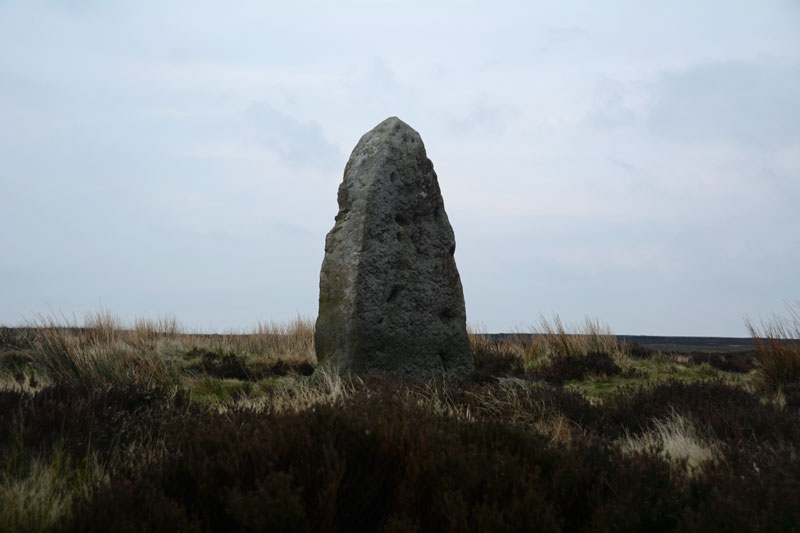
Millennium Stone Danby High Moor submitted by Anne T on 10th Apr 2017. Standing at the road junction of the moorland road from Ainthorpe and Knott Road, this stone sits over a metre above you.
(View photo, vote or add a comment)
Log Text: The Millennium Stone, Danby High Moor, North Yorkshire: Driving at a sedate pace along the moorland road from Wolf Pit Tumulus (which I realised as we got a phone signal back, that we’d picked up the wrong monument), I was really surprised to see what looked like a large standing stone at the junction of Knott Road. Immediately to our left was a small car park with an interpretation board (which didn’t mention this stone), and I spent a good half hour on the internet at home trying to find anything at all about it, which was a brief mention on the Hidden Teesside web site.
Getting out of the car to look more closely at this stone, my fleece and camera were almost blown away by the wind. The temperature had dropped from high teens to single figures in a very short while. I was glad to get back into the car, but pleased to have 'discovered' a stone not (yet) on the map! Next stop was the second 'White Cross' of the day - later discovered to be called 'Fat Betty'.
Three Howes Rigg (West)
Trip No.15 Entry No.2 Date Added: 11th Apr 2017
Site Type: Round Barrow(s)
Country: England (Yorkshire (North))
Visited: Yes on 9th Apr 2017. My rating: Condition 2 Ambience 3 Access 5
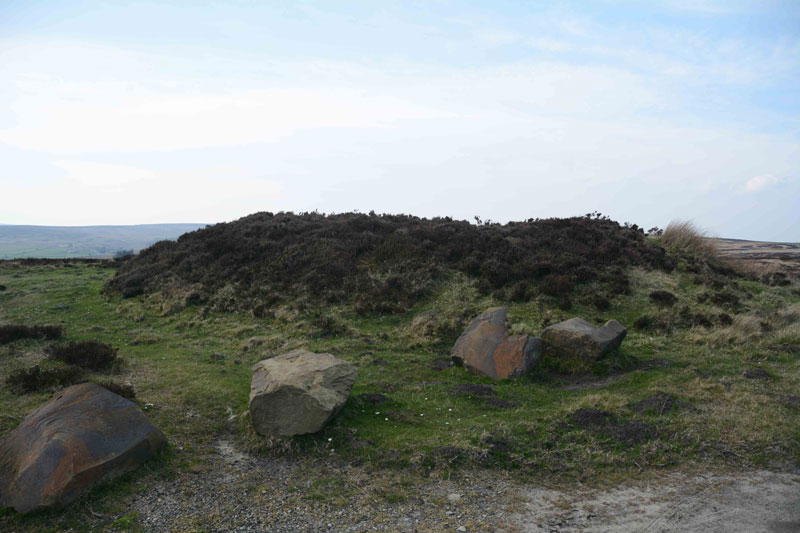
Three Howes Rigg (West) submitted by Anne T on 11th Apr 2017. The larger of the two round barrows on the western side of the road at Three Howes Rigg. The larger boulders presumably stop people from parking and destroying the site, although it creates a handy layby to stop and enjoy all five of the barrows at this location (bar the traffic speeding by!). Sited at NZ 68106 10279.
(View photo, vote or add a comment)
Log Text: Three Howes Rigg (West), Smeathorns Road, North Yorkshire: Despite being called ‘Three Howes’, there are actual 5 barrows in total! It would be easy to whizz by these barrows, as they appear as slight mounds at the top of the ridge. With cars speeding by at a good 60mph or so, it’s difficult to slow down and park, but there is a space between the two barrows on the western side of the road, flanked by large boulders to protect the fourth and fifth barrows.
Once identified, they are obvious in the landscape. Having first stopped at White Cross some 500 metres to the north, being on access land, we tramped over the heather and moorland to take a closer look.
We started with the two barrows to the west of the road and worked our way northwards. The northern-most has been cut slightly by the road to its eastern side; the southern-most was heavily covered in calf-high bracken. We missed the inscribed stone in the middle of this one, but the carving seems to be relatively modern, looking at the Historic England entry.
Three Howes Rigg (East)
Trip No.15 Entry No.2 Date Added: 11th Apr 2017
Site Type: Round Barrow(s)
Country: England (Yorkshire (North))
Visited: Yes on 9th Apr 2017. My rating: Condition 3 Ambience 3 Access 5
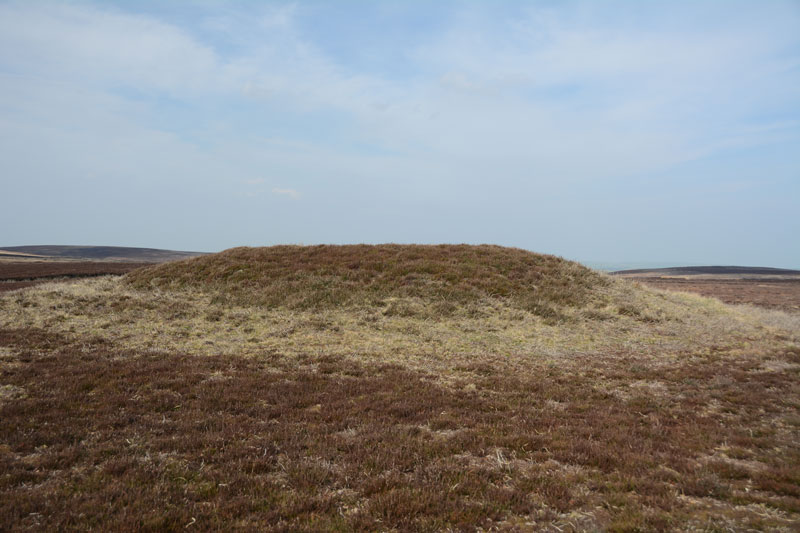
Three Howes Rigg (East) submitted by Anne T on 11th Apr 2017. The northern-most, most visible, of the three barrows on the eastern side of Smeathorns Road. As seen from the road.
(View photo, vote or add a comment)
Log Text: Three Howes Rigg (East), Smeathorns Road, North Yorkshire: Having stopped at White Cross and Three Howes Rigg (West) first, and having 'got our eye in', these barrows rise from the surrounding ground on access land. On the eastern side of Smeathorns Road, and clearly visible on UK Grid Finder, tramping across the heather moorland was easy on the feet.
Now largely used to feed the grouse (full feeding dishes on the tops of these barrows), they diminish in height from the north to the south. There is a fourth mound to the east of the middle barrow, but this looks more like a farmer's spoil heap rather than a barrow, and I couldn't find any reference to it on Pastscape or Historic England.
Looking at the map, there are so many barrows, crosses and other features around here, I'd like to spend more time in this area.
Castle Hill (Whittonstall)
Trip No.16 Entry No.1 Date Added: 13th Apr 2017
Site Type: Ancient Village or Settlement
Country: England (Northumberland)
Visited: Yes on 12th Apr 2017. My rating: Condition 2 Ambience 3 Access 5
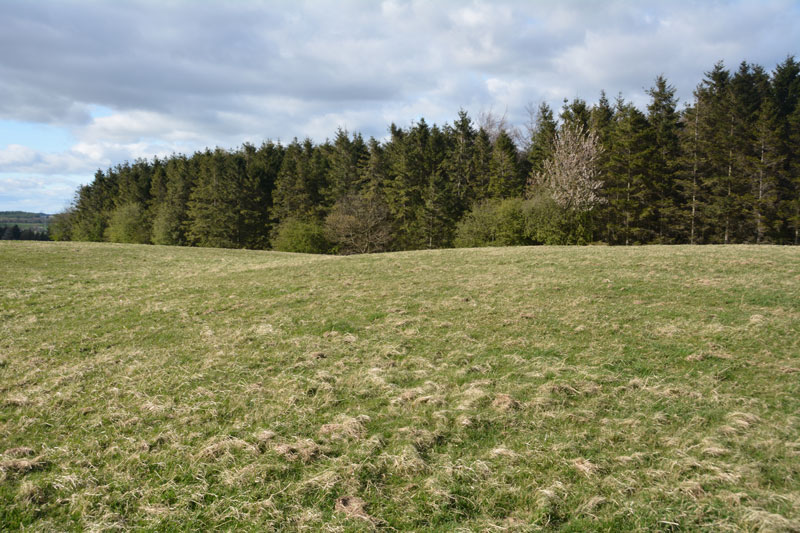
Castle Hill (Whittonstall) submitted by Anne T on 12th Apr 2017. Standing in the slight ditch at the south-western side of the settlement. Much easier to see with the eye than in the photograph.
(View photo, vote or add a comment)
Log Text: Castle Hill, between New Ridley and Whittonstall, Northumberland: This is only a couple of miles from our house, and being a lovely sunny evening, decided to try and find some of the earthworks on the OS map.
This site has the advantage of being close to Wheelbirks Farm with its café, unpasteurised milk and wonderful ice cream. Parking in the layby almost at the junction of the B6309 and the Lead Road, we walked along the busy main road for a couple of hundred yards until we reached the far end of the Castle Hill plantation. Here, the stone wall falls back from the road, and you can walk through to the brambles to the wall. An old gate (?) has been placed so the bars act as a ladder to climb over either into the plantation or the pastureland.
Standing at the stone wall, its possible to see the hump of the settlement with one accompanying outer ditch in front of you. Clambering over into the grassy field (didn't see anyone to ask - sorry), a quick walk along this corner of the field brought the whole of the settlement platform into view. It was much easier to see with the naked eye, rather than try and capture with the camera. Logging onto Pastscape when I got home, I was fascinated to read the history and interpretation of this very ordinary site. Obviously a lot more interesting in the past!
We did go on to Whittonstall to try to find the manorial earthworks not far from The Anchor pub, but these have all been ploughed out. We did carry on to Ebchester, near Newlands, where the line of Dere Street can be seen in the fields to the north east of the B6309. From the gate in the field near the layby almost opposite the junction with the road to Newlands, you can see a cross-section of the road. Interesting.
St Peter's Minster (Conisbrough)
Trip No.17 Entry No.1 Date Added: 18th Apr 2017
Site Type: Sculptured Stone
Country: England (Yorkshire (South))
Visited: Yes on 15th Apr 2017. My rating: Condition 3 Ambience 4 Access 5

St Peter's Minster (Conisbrough) submitted by Sunny100 on 15th Aug 2010. Detailed illustration of the two early Medieval grave-slabs that are both richly carved with an assortment of mythical characters, beasts and symbols. These stone slabs are said to be the finest example of their kind in England.
(View photo, vote or add a comment)
Log Text: Anglo Saxon Carvings, Conisbrough: Having seen this on the Portal, with only a sepia image of the stones, I had been keen to visit this church for some time as it was only a short detour from my step-father's house; the nearby castle had been my very first ever school trip, over half a century ago (gulp). We managed to park in the (small) free car park outside the community centre, right next to the church.
We arrived just as the children’s Easter Egg hunt/service had ended, and children and parents streamed out of the church. With 2 year old grand-daughter in tow, desperate to join in, one lady coming out of the church saw us waiting and asked if we were visiting. When I said we were, she said we were very welcome, waited until the crowds had lessened, then took us in. Another gentleman took us round to see the grave stones and made sure we had the free history leaflet of the church. Grand-daughter and husband made a great game of finding all the Mouseman mice on the pews.
The church, whilst it looks Victorian from the outside, clearly has some very old parts, evident in the blocked up windows in the arches in the nave, and the tower. The church guide tell us that this is the "oldest building in South Yorkshire and is one of the ten oldest churches in England, with parts dating back to at least 750AD." The church warden was telling us that the church came many years before the castle, and so is sited on the highest part of the town; the castle therefore had to take the second highest spot.
As well as the grave stones, there is the very worn shaft of a cross outside, which the church guide leaflet says dates from the very earliest times of this church, around 750 AD. Lovely welcome and well worth the detour. Carried on to look at the castle before heading off into Doncaster.
Exhibition Park Circle
Trip No.18 Entry No.5 Date Added: 24th Apr 2017
Site Type: Modern Stone Circle etc
Country: England (Tyne and Wear)
Visited: Yes on 23rd Apr 2017. My rating: Condition 4 Ambience 1 Access 4

Exhibition Park Circle submitted by Anne T on 24th Apr 2017. Standing at the bandstand side of the mound, looking northwards at the five stones.
(View photo, vote or add a comment)
Log Text: As we’d failed to find the Axwell Park Tumulus, we sat in Café Nero in Fenwicks and I was looked up details of sites we were going to on the mobile version of the Portal. I came across an entry for ‘Leazes Park Circle’ which mentioned a modern stone circle. This took me by surprise, as we’ve been parking our car by Leazes Park when we come into Newcastle, at least once a week, and not come across any mention of this before. Bringing the map up on my phone, we sat puzzling where this was, and decided to head off and look for it.
'Modern Stone Circle', Newcastle: In actual fact, it is in Exhibition Park, not Leazes Park, although I’ve spent a while trying to find more about this on the web. Not finding anything, I’ve emailed the Parks and Countryside Department at Newcastle City Council, simply out of curiosity.
Having stumbled upon the ‘circle’ (the grid reference on the Portal was also a bit off), I’m convinced it’s part of the children’s play park. However, I might yet be proved wrong. When we arrived, a student was walking over the tree trunk to the mound and generally walking around the ditch surrounding this tiny ‘monument’. Disappointing, but pleased to have found it and been able to contribute a photograph to the Portal.
Ryton Motte or Tumulus
Trip No.18 Entry No.1 Date Added: 24th Apr 2017
Site Type: Artificial Mound
Country: England (Tyne and Wear)
Visited: Yes on 23rd Apr 2017. My rating: Condition 3 Ambience 4 Access 4

Ryton Motte or Tumulus submitted by Anne T on 24th Apr 2017. The motte seen from its eastern side. Graves had been cut into most sides of the bottom of the motte.
(View photo, vote or add a comment)
Log Text: Ryton Motte, Gateshead: Parking on the main road opposite The Old Cross pub and Holy Cross church on Barnmoor Lane, as there was an event on at the church, the first surprise was to see the old cross located on the village green.
Pastscape reveals this is relatively modern, having been erected in 1765, but the base looks much, much older. Historic England say in list entry 1018642 that there was evidence of an earlier cross on this site.
A stream of very well dressed people were exiting the church yard, indicating a service had just finished. I spent a few minutes photographing the cross, then we sauntered in the churchyard. The name board on the gate to the churchyard says that the church was founded in 1220, and whilst there appears to be old stones in the fabric of the church, popping our head into the church itself, it looks very Victorian. There were people inside, so we didn’t linger.
Walking round the tower at the west end of the church, and round to the north wall, we came across a man digging up brambles and dock plants around the graves. He told us he wasn’t’ associated with the church, but had got fed up of the graveyard looking as it did. He also said he’d just removed shrubbery and brambles off the motte, which looked bare and brown in the warm sunlight. He also told us to look out for the grave of a woman to the north-west of the motte, which had inscribed on the headstone about the grave also containing her husband, who’d lost his arm at Trafalgar.
The motte is certainly a significant structure (I thought it was only small, but it’s not, measuring 3.30 metres with a diameter of 30 metres, according to Pastscape. The mound certainly appears much higher when viewed from the river side, where it looms high above you.
These days, the river is largely hidden by trees, but glimpses of silver water appear as you follow the path round the motte and back up to the east side of the church. It would have had a very commanding spot above the river when it was built.
Holy Well, Greenside
Trip No.18 Entry No.2 Date Added: 24th Apr 2017
Site Type: Holy Well or Sacred Spring
Country: England (Tyne and Wear)
Visited: Yes on 23rd Apr 2017. My rating: Condition 4 Ambience 4 Access 5
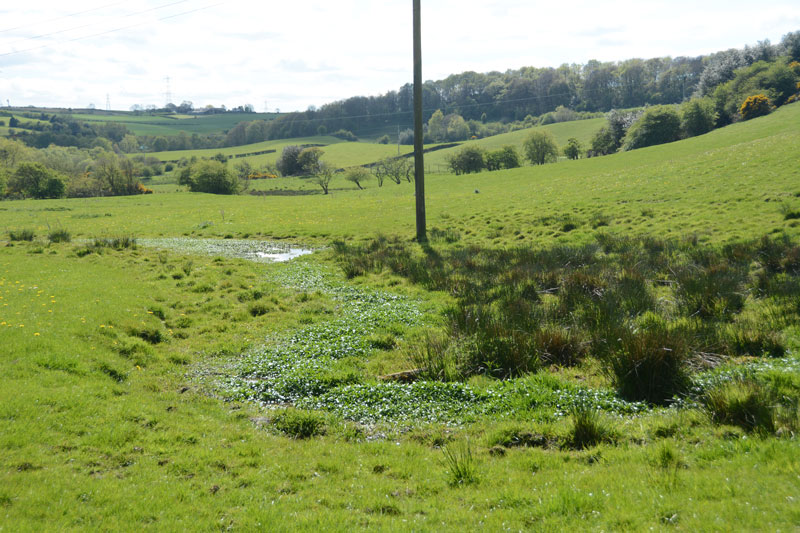
Holy Well, Greenside submitted by Anne T on 24th Apr 2017. Holy Well, Greenside from the gate in the field on Barlow Lane.
(View photo, vote or add a comment)
Log Text: Holy Well, Greenside: From Ryton Motte, we headed off south towards Greenside through the back lanes. Considering how close were are to Winlanton, Blaydon, Gateshead and Newcastle, you could be forgiven for thinking you were in the depths of the countryside at this site. Disappearing down a small road leading from Greenside to Barlow (Barlow Lane on UK Grid Finder) we parked where the lane met a tarmacked path leading to Reeley Mires Farm. It was then a question of walking a couple of hundred yards south-east down Barlow Lane, where the well is located at the base of the Drumlin.
To your right hand side, as you walk down the lane, there is a red metal gate into the field, although this is heavily overgrown by hawthorn and brambles, and is impossible to open. The central pool of the well can be seen at near the base of a telegraph pole, although the whole feature forms an attractive long ‘s-shape’ in the pasture.
It is a really pretty spot here. I was impressed there was so much water here, as it has been little rain here for weeks.
Have as yet been unable to find any notes/further information about this well. Thanks to durhamnature for his original entry.
Axwell Park Barrow
Trip No.18 Entry No.3 Date Added: 24th Apr 2017
Site Type: Round Barrow(s)
Country: England (Tyne and Wear)
Visited: Couldn't find on 23rd Apr 2017. My rating: Ambience 2 Access 5
Axwell Park Barrow submitted by durhamnature on 7th Aug 2012. Axwell Park Barrow
(View photo, vote or add a comment)
Log Text: Axwell Park Tumulus, Gateshead: OK, even with the grid reference, we couldn't find any trace of this - not surprising, since checking the Pastscape records this morning (24th April), they say no trace of the mound exists! There were lots and lots of humps and hollows on the slope to the left of the path as you walk up the hill. The area seems to be part of an estate and has been heavily modified, with an artificial waterfall and stone-lined channels for water visible in the undergrowth.
This area today is on the edge of a modern housing estate, which is still being constructed. The only thing I can say about this is that it is an easy walk up through the park on tarmacked road.
St. Mary's Well (Jesmond)
Trip No.18 Entry No.4 Date Added: 24th Apr 2017
Site Type: Holy Well or Sacred Spring
Country: England (Tyne and Wear)
Visited: Yes on 23rd Apr 2017. My rating: Condition 4 Ambience 4 Access 4
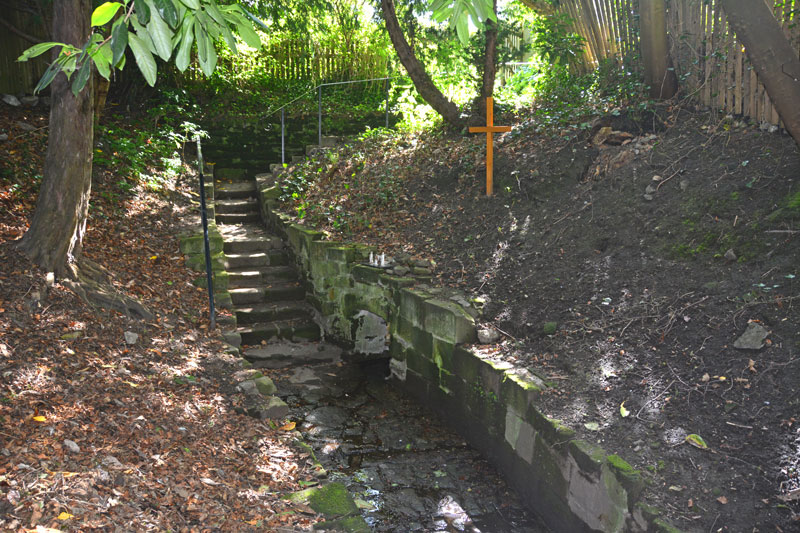
St. Mary's Well (Jesmond) submitted by Anne T on 24th Apr 2017. Standing on the slope above the well pool, looking back at the stone steps leading down to the well.
(View photo, vote or add a comment)
Log Text: St. Mary's Well, Jesmond: From the elusive (non-existent!) Axwell Park Tumulus, we headed off down the Coast Road to Jesmond to find this well. It was a delight – an oasis in the midst of the city.
Parking on Jesmond Dene Road where it meet Grosvenor Avenue, we headed west up The Grove – a shady footpath that runs between The Grove and Red Park Road, in between the back gardens of the houses.
We found the gate to this well to our right hand side, several hundred metres up the path, highlighted by the blue signpost.
Descending into this shady nook, down the stone steps, the first view of the well was of the small statues, tea-lights and mementos left on top of the well covering. As my eyes adapted to the shade, the pool of the well came into view.
The well was full of water, with a steady flow over the cobbles towards the pool. There was a cute copper jug left attached to the side of the well, which I took off and dunked into the water. Andrew and I both tasted the water, and it was completely tasteless, which was a surprise.
After enjoying the peace and calm, we headed off to find St. Mary’s Chapel, now ruined, just down the road. Really enjoyed this visit.
Horsley Hill Homestead
Trip No.18 Entry No.6 Date Added: 25th Apr 2017
Site Type: Ancient Village or Settlement
Country: England (Northumberland)
Visited: Yes on 23rd Apr 2017. My rating: Condition 2 Ambience 3 Access 4
Horsley Hill Homestead submitted by durhamnature on 16th Aug 2012. Meter-wide field stones, part of a collapsed dry stone wall, but perhaps of older provenance.
(View photo, vote or add a comment)
Log Text: Horsley Hill Homestead, Northumberland: Well, this site got the adrenalin racing, if only for the crossing of the footpath across the A69 dual carriageway, at a very fast spot! We parked in Horsley Village on the B6528, outside the Hearth café, and walked up Lead Lane, which runs just to the west of the Hearth, and to the side of the (now) antiques shop. Running past some houses, the tarmacked road quickly becomes a glorious grassy lane. It was very tranquil here, but for the wooden fence and footpath sign at it’s northern end, with the A69 just ahead.
I have to say I’d been worrying about going to this site for some days. We’d tried walking the long way round, from the north of the site, but it was a very long way round. In all fairness, there is a pedestrian sign on both sides of the A69, a tarmacked pavement and gap in the central barrier does aid a crossing. But, with traffic whizzing past a very high speed and heart in mouth, we waited until there was a sufficient gap in the traffic and RAN to the central reservation. It was very odd standing in the middle of such high speed cars and vans on a Sunday evening.
Eventually making it to the other side, the footpath takes a tranquil stroll up to a grassy meadow complete with mobile phone mast with all its electrics. Great views to the north, west and east from here. No wonder our ancestors built a homestead here.
The top of the hill is a large, long oval shape, aligned north-south with slopes down to the surrounding land on the north and eastern side, and signs of ridge and furrow ploughing to the north-east, although Pastscape tells us that this homestead was only 60 metres in length and 47 metres wide.
I’m glad I’d been out with the archaeology group, looking at different banks and features in other areas, as it was a little tricky to make out the low banks which defined this settlement, combined with the more modern trackways from the field gate to the east up to the mobile mast mounds. There are what appear to be very old boundary walls, together with many large stones in an old wall system just to the east of where the northern part of the footpath meets the field, but we concluded this just might be part of the old field system before it was cut by the A69.
The banks were easier to see with the naked eye rather than with the camera. Andrew thought he detected the low, round shape of a roundhouse, but I wasn’t convinced.
A second dash back across the A69 meant I could finally relax. Onto Croft’s Well in the centre of Horsley.
St Alkelda's Holy Well
Trip No.19 Entry No.6 Date Added: 29th Apr 2017
Site Type: Holy Well or Sacred Spring
Country: England (Yorkshire (North))
Visited: Yes on 27th Apr 2017. My rating: Condition 2 Ambience 1 Access 4
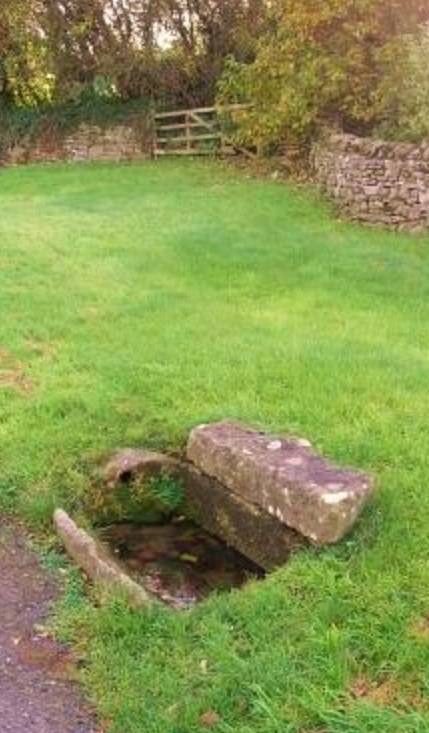
St Alkelda's Holy Well submitted by Sunny100 on 27th May 2010. St Alkelda's Holy Well at SE.124879. Square-shaped stone tank (now dried-up)
(View photo, vote or add a comment)
Log Text: St. Alkelda's Well, Middleham: How tragic – a now dried up well, completely uncared for.
From St. Mary’s and St. Alkeld’s church, I was determined to find St. Alkeld’s Well. Armed only with the mobile phone, OS maps and the grid reference from Pastscape, we set off westwards across the fields, through the gate in the churchyard across a grassy field with a play area at the far end, through a gate leading into where St. Alkeld’s Road and The Springs meet, then through a stile into a grassy field. Measuring the distance between the church porch and the well, the distance is just under 250 metres.
We walked past the well without realising it, thinking it was only a pile of stones and rubble that someone had tossed over their garden wall. On checking the grid reference, we walked back to it.
Having seen the image of the trough by the roadside on both the Portal and Yorkshire Holy Wells, we searched in vain, eventually walking back to The Springs and looking down the driveways. The well is sited at the bottom of the gardens of the two small houses, one called ‘Well Cottage’. Having taken some photographs, we followed the footpaths back into the town centre, ending up at a medieval cross at SE 12607 87679 (see on a previous visit).
St Mary and St Alkelda
Trip No.19 Entry No.5 Date Added: 29th Apr 2017
Site Type: Ancient Cross
Country: England (Yorkshire (North))
Visited: Yes on 27th Apr 2017. My rating: Condition 3 Ambience 4 Access 4
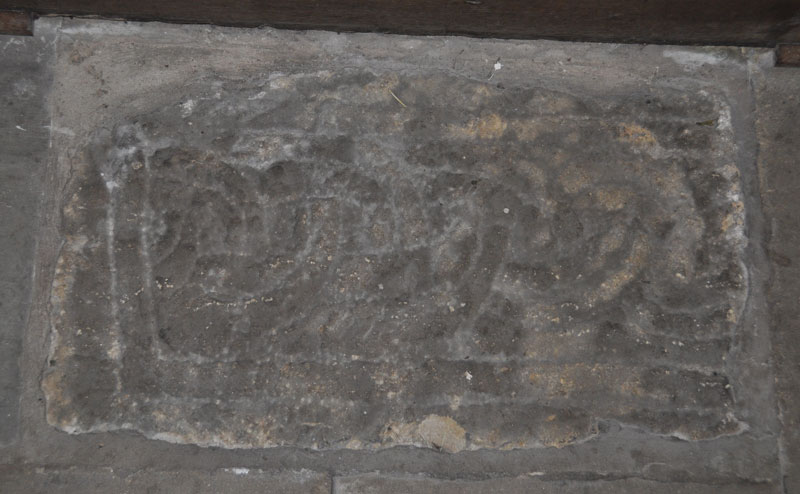
St Mary and St Alkelda submitted by Anne T on 29th Apr 2017. We were unable to get into the church on 27th April 2017, as evensong was in progress, but I found a photograph of this cross shaft embedded in the floor of the nave from a previous visit on 19th August 2013. I am doing some more research to determine the date of this fragment.
(View photo, vote or add a comment)
Log Text: Anglo Saxon Cross Fragment, Middleham: On the way to the holy well, we stopped off to look at the porch of St. Mary’s & St. Alkeld, but evensong was one, so we couldn't go inside but carried on westwards through the churchyard into the fields beyond to find St. Alkelda’s Well.
At home (29th April) reading through the entry from British Listed Buildings, I noted there was mention of a cross shaft fragment built into the floor of the nave. I looked up my photographs from 19th August 2013, when we’d had a holiday cottage not far away, at a time when we weren’t looking for Anglo Saxon cross fragments, and there was one photograph.
After a brief look around the exterior of the church, we carried on through the churchyard to find the site of St. Alkelda's Well.
All Saints (Ingleby Arncliffe)
Trip No.19 Entry No.1 Date Added: 29th Apr 2017
Site Type: Ancient Cross
Country: England (Yorkshire (North))
Visited: Yes on 27th Apr 2017. My rating: Condition 3 Ambience 3 Access 5
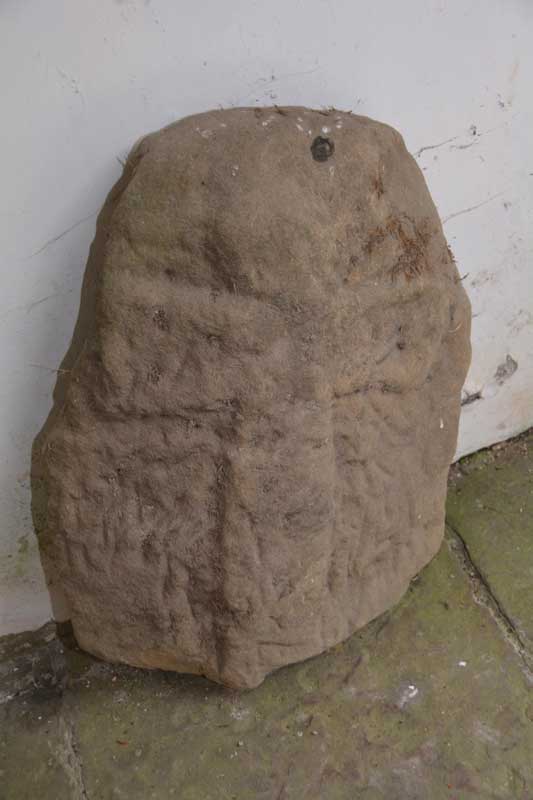
All Saints (Ingleby Arncliffe) submitted by Anne T on 4th Aug 2015. This is the cross which can be found leaning against the north wall of the porch of All Saints, Ingleby Arncliffe. The porch is at the base of the tower.
(View photo, vote or add a comment)
Log Text: Cross fragments (not found), Ingleby Arncliffe, North Yorkshire: We last visited here on 28th July 2015, but the church was locked and I’d arranged for the church warden, to unlock the church for us, although when I’d mentioned the Anglo Saxon fragments to the vicar, he’d replied “this doesn’t sound much like our church.” The stone cross is still located in the porch, shut behind a metal railing door to keep it safe.
Inside, the church is very simple and plain, furnished with box pews, now painted a dusky, dark rose pink. The effigies placed either side of the altar are interesting, together with some stained glass in the east window, which the Yorkshire Moors Gazeteer says represents the Fauconberg and St Quintin families. One of the effigies is of Sir William Colvill, the other of his brother, Robert. These effigies are both in armour with ailettes, and hold hearts in their hands. The British Listed Buildings entry for Ingleby Arncliffe says the ailettes (the origin of modern epaulettes) is a 'very rare feature'.
The vestry was locked, so we couldn’t get in. We also hunted high and low around the tower for possible cross fragments. I took photographs and have since enlarged them using Photoshop, but these only show weathered sandstone.
A disappointing visit, but we tried to find these cross fragments.
All Hallows (Bardsey)
Trip No.19 Entry No.3 Date Added: 2nd May 2017
Site Type: Ancient Cross
Country: England (Yorkshire (West))
Visited: Yes on 27th Apr 2017. My rating: Condition 3 Ambience 4 Access 5
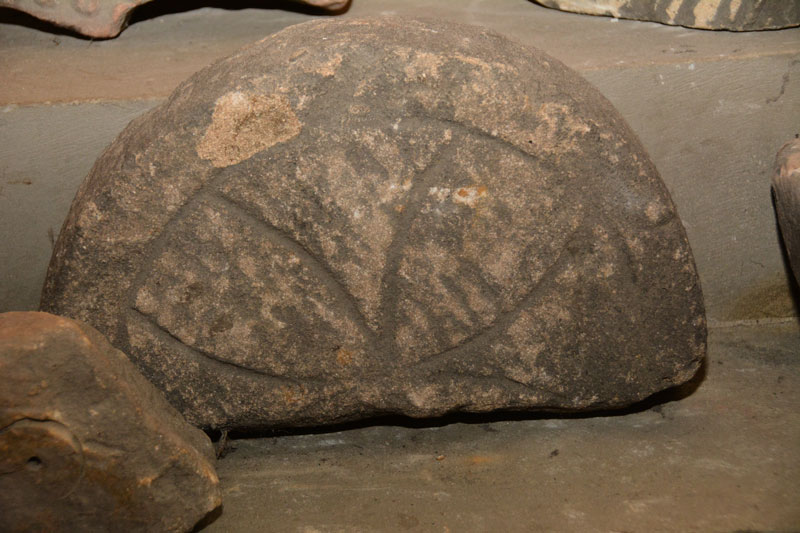
All Hallows (Bardsey) submitted by Anne T on 2nd May 2017. Close up of the cross head fragment. This is very similar to one embedded into the vestry wall at St. Oswald's @ Collingham.
(View photo, vote or add a comment)
Log Text: Anglo Saxon crosses, Bardsey, West Yorkshire: This is a very lovely spot, not far from the main A58 travelling south into Leeds. Considering how close it is to the main road, this is a peaceful, tranquil spot. Having checked with the parish office beforehand, the church is open all day until 5pm.
First impressions of the building were lovely. Approaching from the west wall, there is evidence on the external wall of many different roof lines, inserted windows and additions. Inside the building it is fascinating to see the tower, complete with windows, now completely absorbed into the interior.
Whilst there, a group of four people came in and started asking us questions about the building, of which I could only answer a couple. We gave them the church guide leaflets.
I found the collection of ancient stones on both sides of the door into the Maleverer Chantry. I most liked the 12th century font bowl, which Andrew found in two pieces at the base of the steps, tucked into a dark corner, the cross head fragment and the 11th century grave marker inscribed with a crude Latin cross.
Collingham Crosses
Trip No.19 Entry No.5 Date Added: 2nd May 2017
Site Type: Ancient Cross
Country: England (Yorkshire (West))
Visited: Yes on 27th Apr 2017. My rating: Condition 3 Ambience 4 Access 5

Collingham Crosses submitted by Thorgrim on 22nd May 2005. Dated to about 875 AD (the early years of the Viking occupation of the land around York) this cross is known as the Aerswith Cross. It shows clear Jellinge style carvings in the Danish manner.
(View photo, vote or add a comment)
Log Text: Collingham Crosses, West Yorkshire: What are the chances of meeting someone whose grandparents built the house you live in now and has recollections of visiting, together with photographs of what the house used to look like? The grandparents of Rev. Sylvia Earle who is vicar of Collingham did in fact build our house, and she was able to tell us what it was like when she was younger, and provided us with a photograph of what our (then) bungalow was like when it was first built.
The church has to be kept locked these days as Rev Earle told us someone had stolen a fragment from the west end, and someone tried to set a fire against the wood panelling at the east end of the north aisle. Shame.
We were left with the keys to return once we’d finished, so spent a good 40 minutes wandering around the church, photographing the crosses and fragments, including the cross fragment built into the north wall of the vestry. The Victorian builders built the nave and chancel at an angle. The Runic and Apostle crosses were lovely, together with the unusual round creset.
Most of the furniture within the building looked new and well cared for, with pristine kneelers. Much enjoyed this visit: we were made very welcome and this is a pleasant sanctuary inside, although the noise from the A58 invaded the privacy of the churchyard.
Old Fulling Mill Museum of Archaeology
Trip No.20 Entry No.3 Date Added: 1st May 2017
Site Type: Museum
Country: England (County Durham)
Visited: Yes on 30th Apr 2017. My rating: Condition 3 Ambience 4 Access 4
Old Fulling Mill Museum of Archaeology submitted by durhamnature on 21st Jul 2012. The amazing setting for the museum- its the red-roofed building on the riverbank.
Site in County Durham England
(View photo, vote or add a comment)
Log Text: Old Fulling Mill, Durham: Now closed to the public. All exhibits have been transferred to the University of Durham Museum of Archaeology at Palace Green.
We walked up and down, then down and up, this lovely riverside path, directly underneath Durham Cathedral and the Castle, looking for St. Cuthbert's well. It is in a really lovely spot, although very close to the river, but as the signboard said, must have been prone to flooding.
Having read in the Portal entry that this museum contained examples of rock art, I was keen to visit, but the sign firmly said the museum was now closed. The University of Durham now have an on-line resource, but would love to go and pay a visit. At this time on a Sunday afternoon, it would have been closed, so a repeat visit will be necessary, but as it's such a beautiful location, and not far from home, this will not be too much of a hardship!
Galilee Well
Trip No.20 Entry No.1 Date Added: 1st May 2017
Site Type: Holy Well or Sacred Spring
Country: England (County Durham)
Visited: Yes on 30th Apr 2017. My rating: Condition 4 Ambience 4 Access 4
Galilee Well submitted by durhamnature on 24th Sep 2012. The Galilee Well
Site in County Durham England
(View photo, vote or add a comment)
Log Text: Galilee Well, Durham Cathedral: We arrived at the Cathedral only to find large marquees on the lawn outside, lots and lots of heavy duty cable laid neatly across the lawn. The west walls had been cordoned off with iron railing with filming equipment piled behind.
We decided to go to the café for tea and a sandwich then asked the guides at the desk where the well was and if we could access it. The lady who replied told us “there’s a really big event on at the cathedral; it’s only just been put on the web site. Even we aren’t allowed to go down there.” Helpful.
I remembered years ago walking up to the cathedral from the bridge on Silver Street, an old entrance tucked between two buildings, labelled the old Pilgrims Way up to the cathedral. We walked down into the town, found the entrance and followed the steps up the hill only to find out the path has been blocked off part way through. Retracing our steps, we found the riverside footpath which runs between Café Rouge and Geek Squad/9 altars café on the southern side of the river, at NZ 27282 42419. This path, high above the river, leads directly to the bottom of the west walls and the Galilee Well.
There is no information on this well on Pastscape, or in the cathedral notes for the Gaililee Chapel which must be immediately the other side of these enormous walls.
As the footpath is relatively narrow and has a steep drop down to the river Wear below, it was interesting to get a full face on photograph. The drop from the well into the water below is at least a couple of metres. There was no water flow at the time of our visit. Whilst standing on the path, I noticed a shelf of flat stones poking out of the bank very slightly. Whilst looking back up at the well from St. Cuthbert’s Well below, I noticed what looked like a cast iron bowl poking out of the sheer cliff. Is this associated with the Galilee Well? A pretty inaccessible place!
There is some information on the wells in Durham on the 'Ancient, Healing and Holy Wells of County Durham' by Laurence Hunt which we found useful in giving directions and information.
St. Oswald's Well
Trip No.20 Entry No.5 Date Added: 1st May 2017
Site Type: Holy Well or Sacred Spring
Country: England (County Durham)
Visited: Couldn't find on 30th Apr 2017
St. Oswald's Well submitted by HOLYWELL on 15th Jan 2011. St Oswald's Well in the gloom. Some old brickwork can be seen.
(View photo, vote or add a comment)
Log Text: St. Oswald's Well, Durham: From St. Mary’s Well, we headed off along the footpath by the side of the river, on the outer bank of the river Wear as it curves south and east around the cathedral. It is a very pretty path, although with quite a steep drop on the river side at times. We were amused by the ladies rowing on the river who went into the bank once or twice!
Reaching the outer walls of Hatfield College, we climbed some steps onto a path leading us onto Anchorage Terrace and followed the road north towards St. Oswald’s Church. The grid reference as given showed the well to be in the vicinity of the school. After much walking around St. Oswald’s churchyard, I eventually pulled up the description from the Ancient, Healing and Holy Wells of County Durham by Laurence Hunt, which told us that the well was “Situated just below the footpath leading from St Oswald's churchyard to Prebend's Bridge. Reached down a narrow, steep footpath about 20 yards after entering the trees below the church tower.”
Following our steps back to the tower, there is indeed about 20 metres through some trees back to the footpath. Just to our left there was a small, very overgrown track leading down what (to me) looked like a death-defying drop down the cliff to the river below.
Husband Andrew, being intrepid and with absolutely no fear of heights, swung himself onto the footpath, clung onto a tree and leaned over. He said he could see the well. I closed my eyes.
After a few minutes he reported that about 3 metres of the footpath appeared to have slipped down the slope and was missing, and he could reach the well but would like a rope!
We aborted the visit, sadly.
